From The Beginning
Sometimes I wonder whether I’m an idiot for spending so much money on travel. In the last three years, I’d poured nearly all my savings into traveling, having visited Peru and Bolivia, Melbourne, Fiji, and Tonga (though fortunately, the latter was a family trip). As a result, I emerged from uni flat broke. So once I had finally worked for a year and amounted some decent savings, it was hardly surprising that I decided to spend it on yet another trip . Finally, I could take that gap year that Covid had so cruelly snatched away four years prior.
Finn, on the other hand, had been possessed by the spirit of engineering to do a fourth year at uni. He’d also bought a share of a house. So while we were matched in enthusiasm and desire to explore Europe, we weren’t playing on a level field. We endeavoured to move back home and work as hard as we could for five months, until Finn graduated in late April and we took off. We sold everything and left the country on a one-way ticket, 16 grand in Finn’s account and bit more in mine.
We landed in Istanbul with no idea where we were going, how long we would be away for, and definitely no idea of how much it would cost. Sorry to my Type A friends, I hope you’re not horrified at the thought of this. But (at risk of sounding like an arsehole) I knew I was an experienced traveler, and I was confident in our abilities to travel cheaply and intuitively. We just needed to keep one eye on the bank and be prepared to change plans on the fly. If things went wrong, we had bought travel insurance until November. If things went really wrong, I had a credit card that could buy us flights home.
Read on for some thoughts on the nature of traveling on a budget, and a breakdown of our costs so far.
Disclaimer
You might think it’s weird for us to be sharing all this financial stuff on the internet. It certainly feels a bit weird to me. But we started this blog with the purpose of providing a raw and honest account of our journey- the good, the bad, and the financial. If we didn’t talk about the money aspect, this would not be a fair account. Especially as young people, money means everything. Even if we wish it didn’t. Sometimes it feels like the single biggest blockade stopping us from fulfilling our dreams. So it’s kind of a big deal, and it’s important to talk about it.
It’s also important for me to acknowledge that everybody is going to be reading this from a very different place, with their own financial stories. There is no “normal” or “expected” amount that a person can/should save for a trip. We were only able to save as much as we did because we had support from my parents, who let us live and work at home without charging rent. We’re also lucky enough to have family and friends scattered around Europe, with whom we can stay for free. But equally, Finn has the added extra cost of his mortgage, which comes out of his savings every month, whether he’s earning money or not. So I’m not sharing this stuff to compare with anybody; it’s purely supposed to give you an idea of how we’ve saved and spent in our specific circumstances, and maybe that will be helpful.
How Much is Enough?
Money is one tricky enigma. When you’re going on an open-ended overseas trip like this, how do you ever know when you’ve saved enough? When you don’t even know what countries you’re going to, how can you budget your expenditure? There’s never a right answer. We could have stayed in Christchurch and worked for another year, tripled Finn’s savings, and made ourselves more comfortable. But what’s to say we would have been content at that? Perhaps we would have started saving for a house together, or raised our standards for a more expensive trip. You’ve got to pull the trigger at some point, and due to the element of the unknown, it’s never going to feel 100% comfortable. So stuff it. We had caught the travel bug, and boy, were we itching to leave.
My philosophy is to travel while you’re young. Travel while you’re old, too. Travel whenever and however you can. But young-person travel is a fundamentally different experience to travelling when you’re, say 30 or older. We are talking entirely different kettles of fish. If you put it off for too long, keep waiting for a “just a few more years, when I have more money”, you’ll be truly an adult before you know it. By then, you’ve completely missed out on the adventure that is young, cheap, adventurous travel.
Young Travel vs. Old Travel
I’m not talking out of my arse here- my philosophy is research-backed. There’s a very interesting study by Laura Cartensen on Socioemotional Selectivity Theory and how our perception of time affects decision making. I think it supports my distinction between young-person travel and adult travel. Skip this part if you’re not into psychology, or if the mere thought of scientific journals gives you PTSD (fair enough).
Cartensen’s research suggests that in social situations, people ultimately have one of two goals: either “learn something new” or “feel good”. Oftentimes, one of these goals will come at the expense of the other. For example, if we want to learn something new, we might try out a new restaurant to learn whether or not it is a good place to eat. But you put the “feel good” condition at risk, since the food could turn out to be horrible. Or, if you would rather feel good than learn something new, you might go to a restaurant you’ve already been to before, thereby having a tasty meal at the expense of a new experience. This study shows that whichever goal you pursue is influenced by how much time you think you have left, both on the trip, and in your life.
So if we are young, and we think we have an abundance of time left, people tend to aspire to the goal of gaining knowledge. Therefore, we are more likely to pursue new experiences, chat to strangers, and change plans on a whim. Learning something, like “I hate overnight buses” or “this person is actually really cool”, is useful in the early stages because we learn about ourselves and can inform future decision-making for the rest of our lives. This goal changes as we get older. When we feel like we have limited time left, people tend to prioritise emotional experiences, like going to a sentimental place or spending time with someone we already know. The nearer we get to the end, the more important it is for us to make every day feel happy.
So traveling like a young person- being poor and adventurous and taking risks in the pursuit of knowledge- tends to be a temporally-bound experience. Of course, you can still adopt this style of travel when you’re older, but the point is that you’re less likely to want to, especially when you’re not provoked by necessity. If you have a large sum of savings, you are much more likely to adopt little luxuries, simply because you can. That’s great, but if you opt for a private hotel room instead of a 12-bed dorm, you’re not going to meet that really cool person, or if you go to a fancy restaurant instead of that street food cart, you might not get to see how they make authentic Chicha Morada. There is a time and place for this comfortable kind of travel, and it’s not in your early twenties.
What’s the Point?
Since everyone travels differently, it’s important to think about your own goals and purpose for traveling- what do you actually want to get out of your trip? For me, this journey isn’t a holiday in the traditional sense. As we explore Europe, I’m aiming to see and do as many new things as possible and immerse myself in different cultures. Finn is focused on meeting like-minded explorers and building an international network of friends. Because of this, we’re not prioritising comfort; we’ll happily choose the “dodgier” option if it means a richer experience or the chance to meet new people. Other travelers might have very different priorities, from relaxation and relationship-building to self-discovery and adrenaline. Whatever your motivation, it helps to be clear about your purpose with yourself and your travel partners so you finish feeling fulfilled and not burnt out.
Let’s Talk Numbers
It can be really hard to strike a balance between spending enough to have fun, but still keeping it cheap. I’m not going to lie, Finn and I can really struggle with finding this invisible line. On one hand, there’s no point coming this far just to miss out on every experience because it’s expensive. Money shouldn’t be this prohibitive. But on the other hand, it’s very easy to get swept up in the luxuries of travel, and every time we restrain ourselves from splashing out it means we can keep going for longer. It’s very hard to walk that line, and we often find ourselves see-sawing over both sides.
So now you’ve got some context, I’ll share with you some numbers on how much we’re spending so far. Due to our see-sawing, I’ve tried to make it clear which parts of the trip we’ve had a more relaxed approach to spending, which parts we’ve been more strict on budget, and which parts have been influenced by staying with family or volunteering via workaway. It’s important to note that I have not included here the cost of international transport, since this will vary depending on where you’re coming from. I have included only the cost of domestic transport within the country.
Key
Green: Relaxed approach. We ate out at restaurants almost every day, though we chose relatively cheap ones. We did paid activities like boat trips, archaeological sites and car rentals.
Blue: Budget approach. We ate mostly from supermarkets and prioritised free activities like swimming, hiking and free museums.
Yellow: We spent a large portion of time here volunteering with Workaway, so we got accommodation and some food for free.
Pink: We spent a large portion of time here staying with friends or family, so we had free accommodation and some free food.
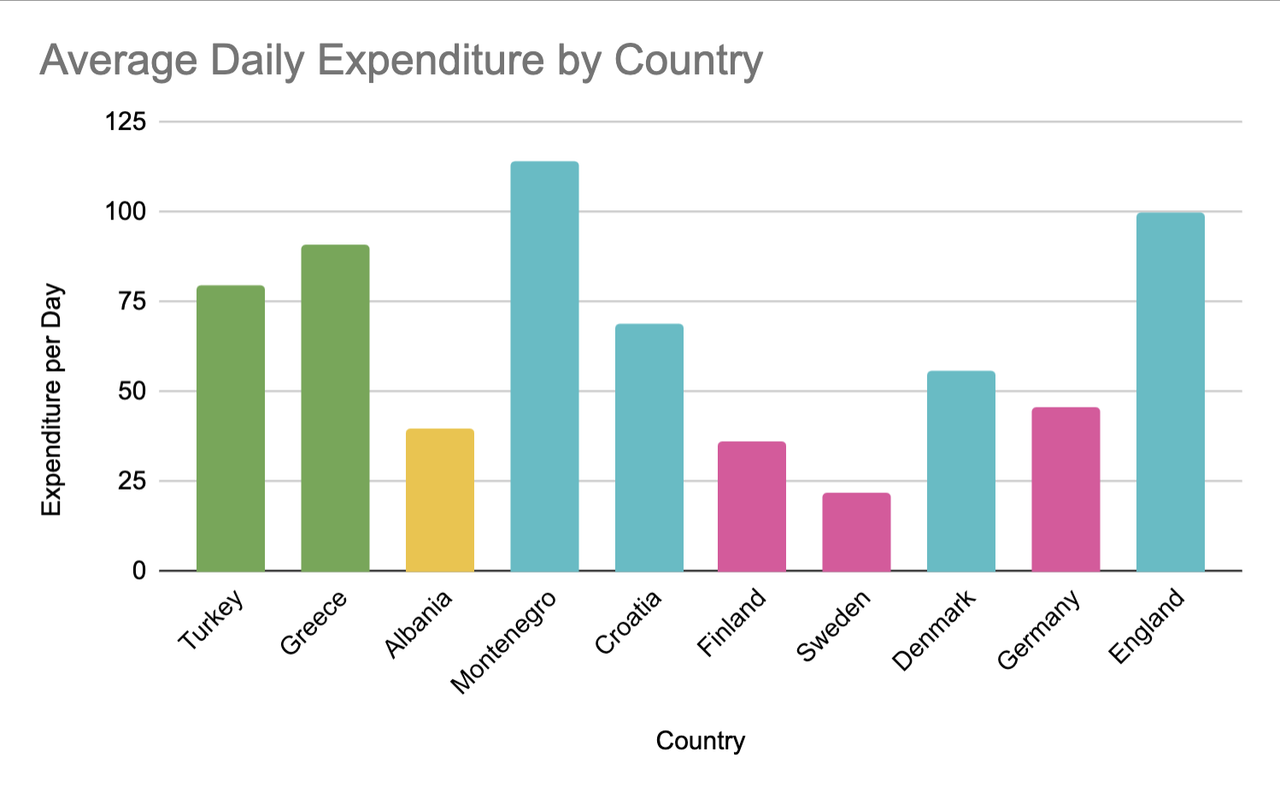
Breakdown
I have excluded any countries from the breakdown for which we stayed less than a few days, including Montenegro, Croatia, Denmark and Germany, since the data is insufficient to really make a fair analysis. But you can get an indication of the average daily cost in the above bar graph.
Turkey and Greece
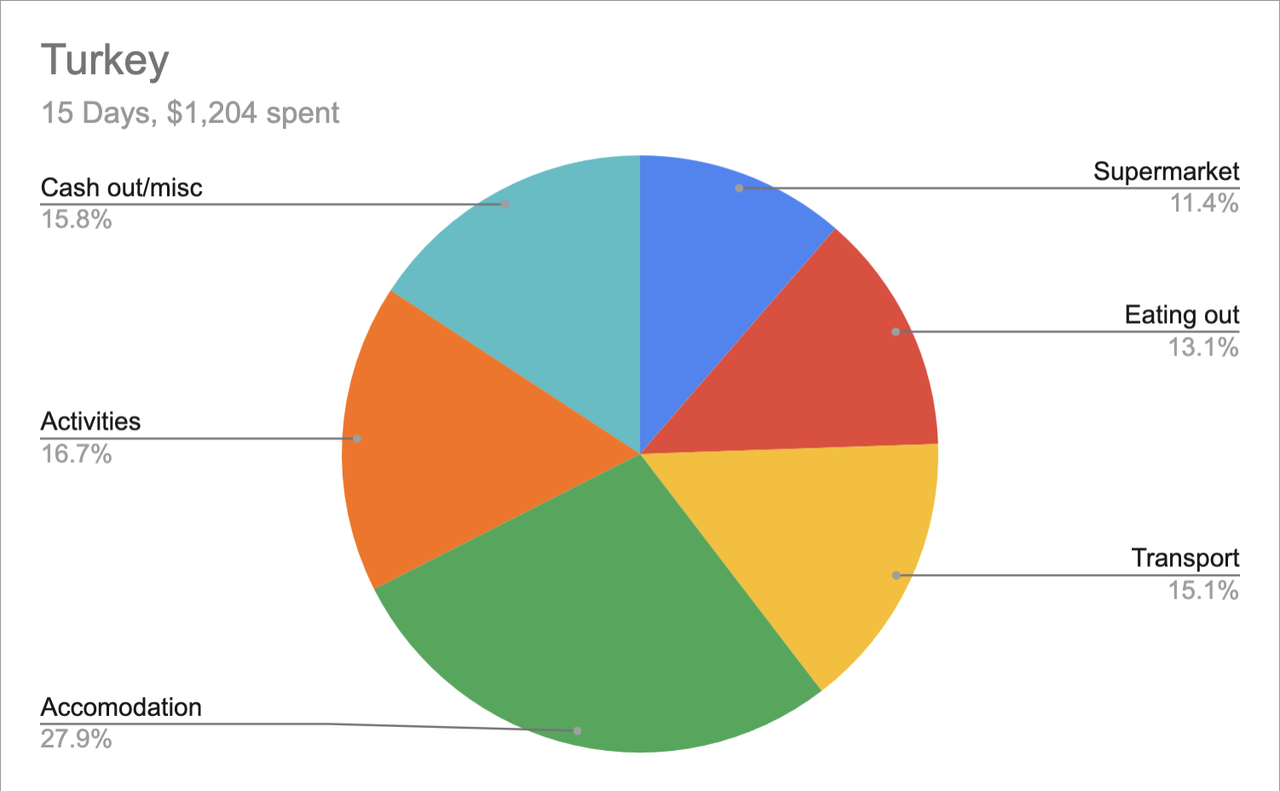
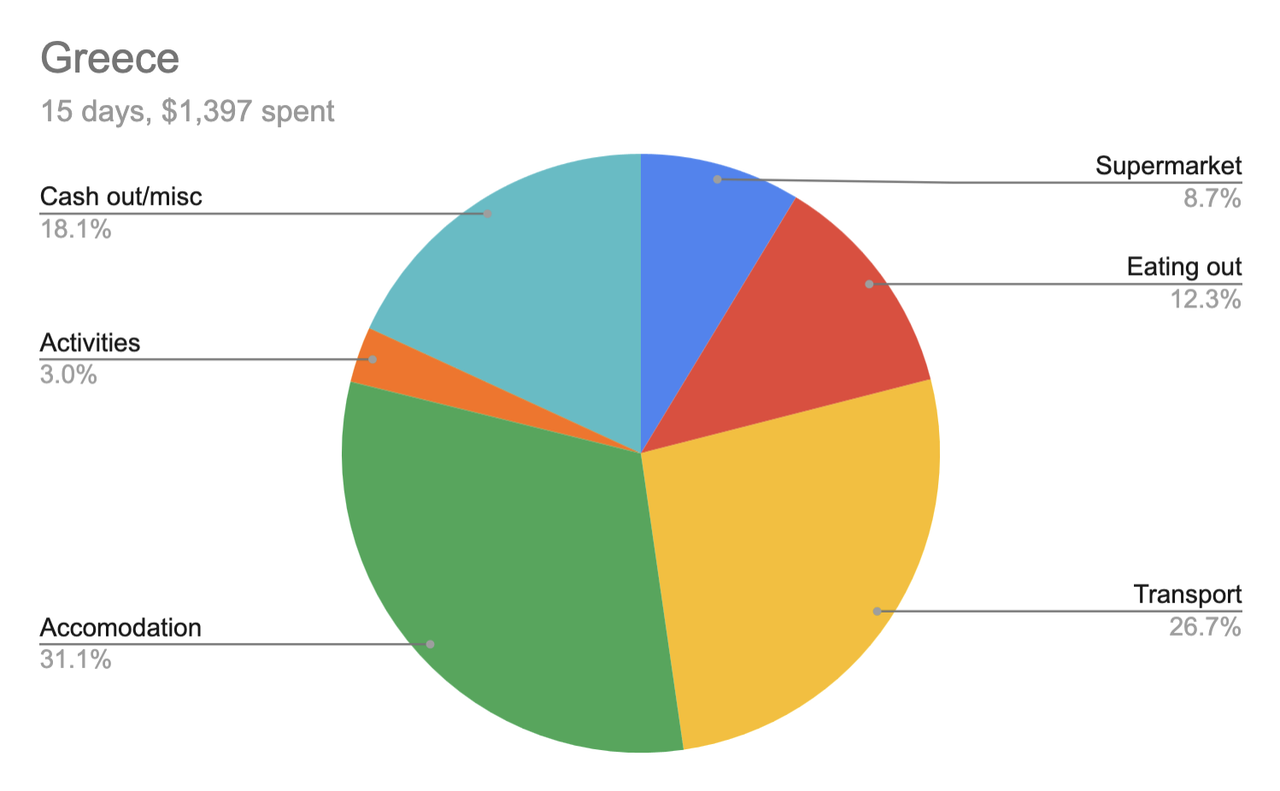
Our first month in Turkey and Greece was so much fun; we took a relaxed approach, as this was like our holiday that we’d been waiting for. Greece was slightly more expensive than Turkey, I think, particularly because the locations we went to were more touristy there, like Rhodes and Meteora. On average, we spent $80 per day in Turkey and $91 in Greece. These are really affordable countries and worth traveling in a relaxed way while you’re here. It only cost $4-8 for a gyros/kebab, so we ate out all the time
Albania
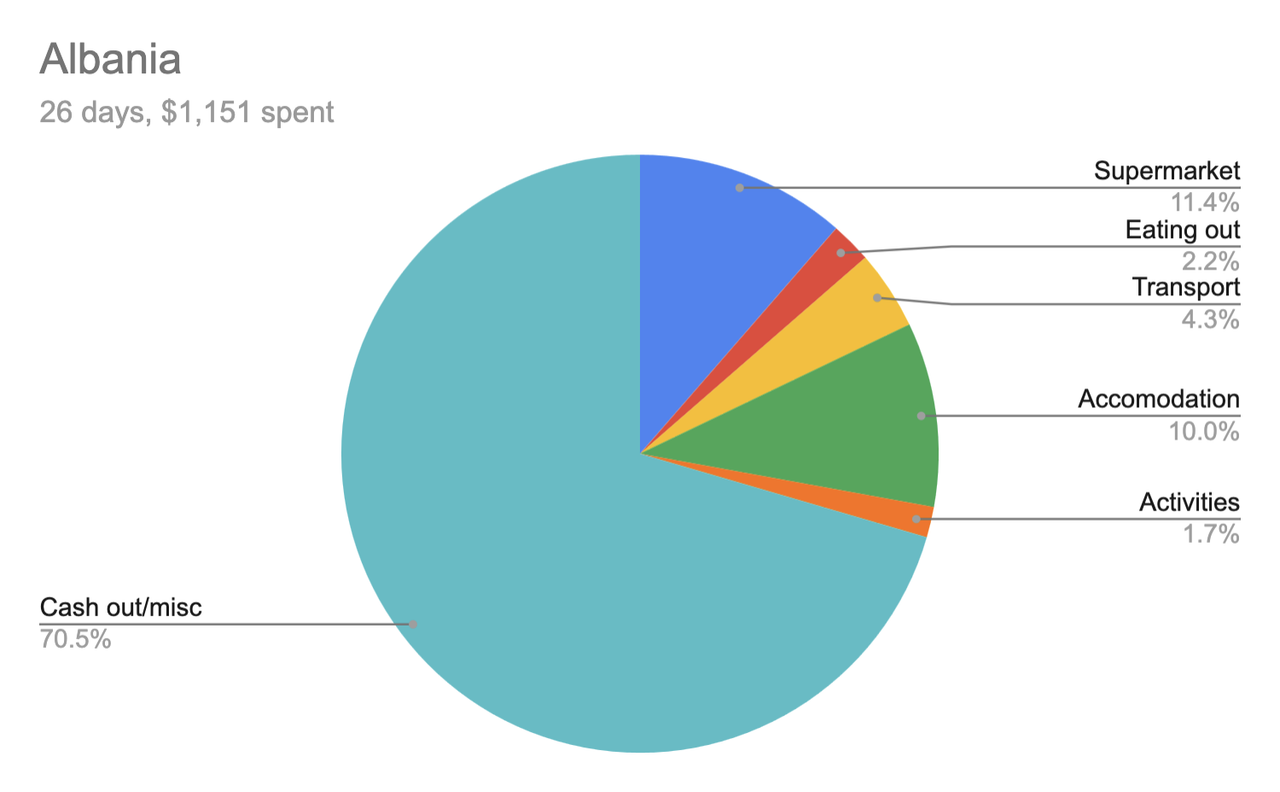
Albania is a tricky one to convey to you. It is so incredibly cheap that, like Turkey and Greece, I would recommend visiting if you want somewhere to live large. The accommodation cost is so low because we spent more than half our time here volunteering in a hostel- we saved over $300 in accommodation. Breakfast was also included at this hostel, so that’s deducted a little bit from the supermarket section. Again, it was only $4 for a Kebab down the road, which was literally cheaper than cooking from scratch. Transport was incredibly affordable because the buses are so cheap. They’re not that comfortable, but the country is rather small, so luckily you don’t have to endure them for too long. There’s not really much to spend money on activities-wise here, I think the only thing we did was a day tour around Osumi Canyon. Other than that, you just explore, swim and drink.
The elephant in the room is the sheer amount of cash we got out from ATMs. Except for some supermarkets and hostels, the country pretty much entirely runs on cash. This made it really hard to track our spending! So I’m sorry I can’t be more specific than this, but it’s safe to assume that out of that 70%, most cash went towards food, with maybe 12% towards accommodation.
Finland

We were only in Finland for 6 days, and we spent them all with our friends Sam and Elli. So fortunately, there were no accommodation costs. By far the biggest portion of our spending was on supermarket food- this is because supermarkets are insanely expensive in Finland! I think we only ate out once at Hesburger (a fast food chain), so the vast majority came from the supermarket. Unfortunately, we have to eat, so this cost is rather unavoidable. We didn’t take any public transport, so the yellow portion represents fuel costs (which is also relatively expensive) for the car that we borrowed. We had a great time doing a mix of free and paid activities, from a sauna-park to a clay workshop and lawn games at Elli’s cabin.
Sweden
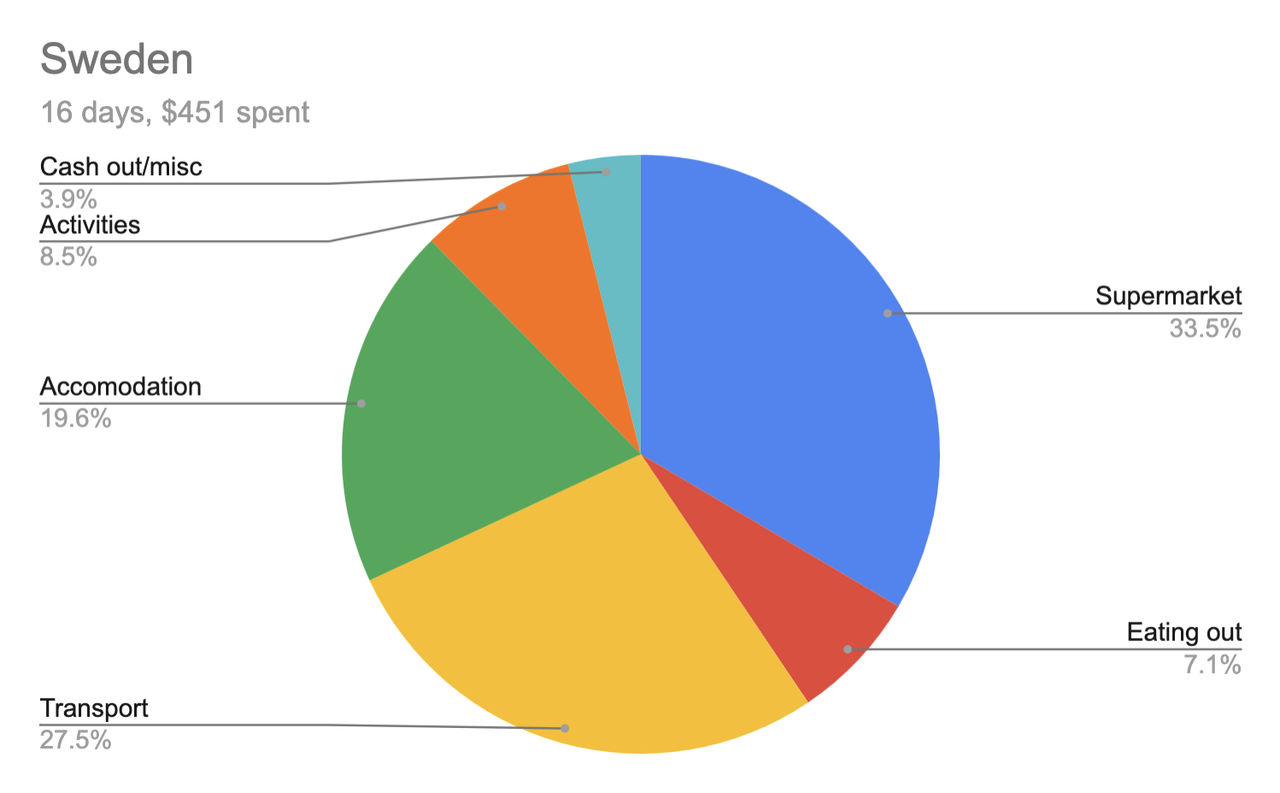
Sweden should have been much more expensive, but we were incredibly lucky to spend almost the entire time with family friends. If we hadn’t, it definitely would have been the most expensive place on our trip. We only paid for accommodation for a few nights in Stockholm, so had we visited on our own that portion would have taken up much more of the graph. The transport was not cheap either, though we were fortunate to have been able to borrow Emma and Bernt’s train passes for many days. Like Finland, the supermarkets were also pretty expensive here, and eating out even more so.
England
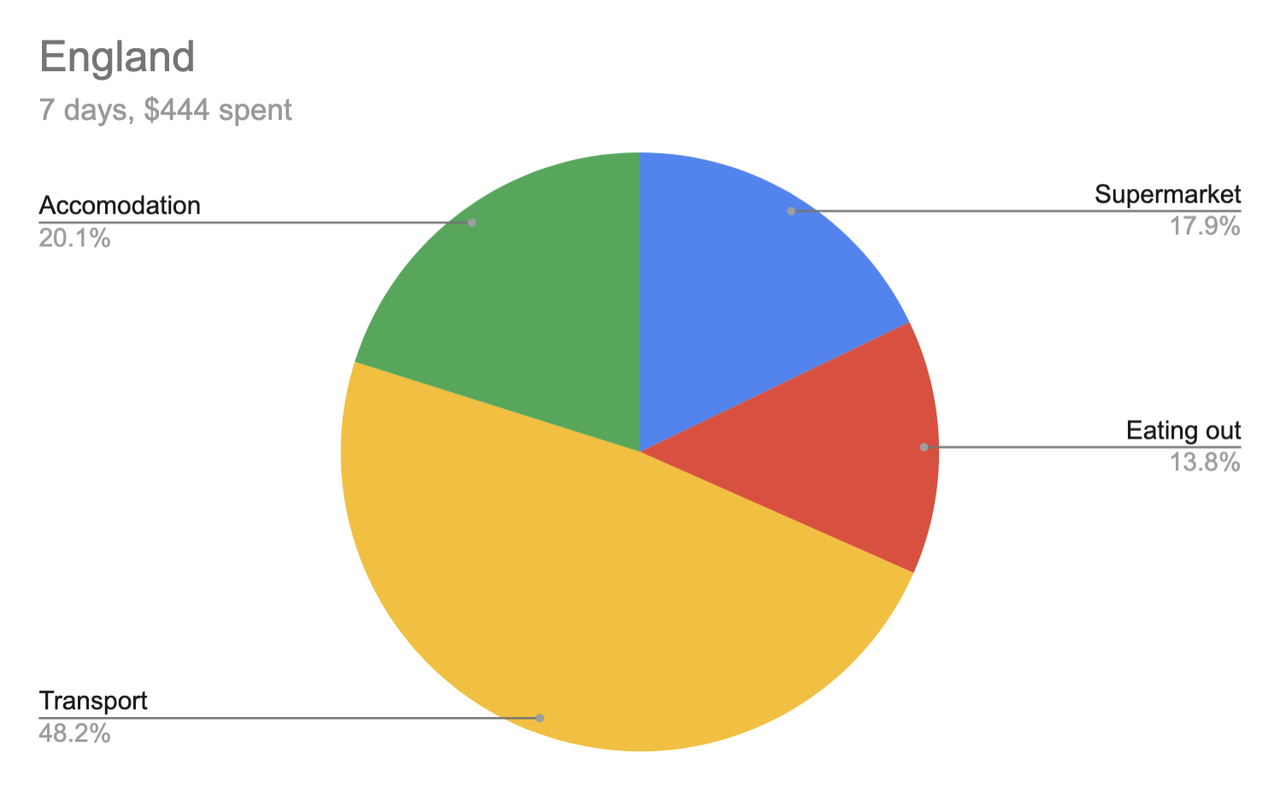
We were only in England for a week before heading into Scotland. Three days were spent in London Central, and the other four in Baldock on a pet-sit. So this is a bit of a tricky one to convey. We saved some money on accommodation; instead of spending $60 for the week, it should have cost us about $180. The supermarkets were marginally affordable- slightly cheaper than in New Zealand I would say. But nowhere near as cheap as in Southern Europe or Germany. Transport was by far the biggest cost, since the regional trains in the UK are incredibly expensive. The UK is the only place where Eurail is actually worthwhile in my opinion (but more on that in a future post). The tube wasn’t as cheap as I expected either, though it was convenient, especially with an Oyster card. On the plus side, we didn’t spend any money on activities, since there is so much free stuff to do in London, including all of the big museums!
Conclusions
I doubt you were surprised by our breakdowns of which countries were the most expensive.
Considering we spent freely in Turkey and Greece, we still spent well under $100/day since they are nice and affordable countries. Albania was even cheaper- it was definitely not necessary for us to do volunteer work here to save money, we just did it because we loved it. It would be another good place to go on a relaxed budget.
We were only in Montenegro and Croatia for a few days each, but they were very expensive. I think this is because we stayed at what were hands-down the most touristy places (Budva and Dubrovnik). I don’t think they are a fair comparison to the rest of the country, which I expect would be closer to Greece’s spending on average.
The Nordics were the most expensive, unsurprisingly. The only way we were able to go was because of our connections there- I wouldn’t recommend it to the budget traveler because even the bare necessities like supermarket food are much more expensive than in New Zealand. There is so much to see and do there, perhaps I would advise saving that one until you’re ready for the “adult” traveler lifestyle.
I’m reserving my comments on Germany, since we only visited Hamburg for 2 days. But we will be returning to Germany for a decent chunk of time in October, so I will make sure to report back! But I will say that, on first impressions, German supermarkets were very cheap compared to the rest of Europe, so that’s a good sign.
Finally, England is very expensive considering we spent the majority of our time there with free accommodation. Accommodation can get pretty pricey in London, though we didn’t pay an exorbitant amount at the time of year we visited. The biggest thing that will get you in this country is certainly the transport- not only is it expensive, but it can also be limited and unreliable. In terms of affordability, I would put England at some middle-ground between the Nordics and the Baltics. I would recommend visiting as either a young or an older traveler, but if you’re young you will likely need to stick to a strict budget- reserve your splashing out moments for cheaper countries where it will go further.
I hope this has been helpful or interesting to you. Stay tuned for an update later down the line, where I hope to compare Scotland and some of Central Europe.
Signing off,
Milly x



6 thoughts on “Let’s Talk Money”
Wow I was surprised about the transport costs in the UK. But what an interesting breakdown.
I had to laugh at your reference to 30 been old! I’m positively ancient! But you are right – your tolerance to roughing it does diminish with age – well and truly. And I totally agree with your philosophy of travelling when you are young. Life has a terrible habit of getting in the way – so travel when you can.
Fantastic financial analysis Milly, perhaps you could send a copy to Nicola Willis. It might help her understand reality.
Love your stories. Keep it up.
Some great budget learnings through your travels, and such detailed analysis!
Curious to know how you have been tracking your expenses, are you using a particular app, or just through your banking, or just keeping really careful records? You might be surprised at some of the price hikes here since you both left not so long ago… don’t even get us started on the price of butter….
Thanks! We have been tracking our bank accounts plus a lot of what we spend one person will pay and we record it in a cost sharing app (Splitwise), which gives us a pretty good overview. Milly went back a loooong way to add everything up, was a bit of a mission! Also, as much as I’ve been hearing about the cost of butter in NZ, can’t help but feel it isn’t much better here, average £1/100g…
You need to come home immediately. Daisy is missing you.
From Scarlett.